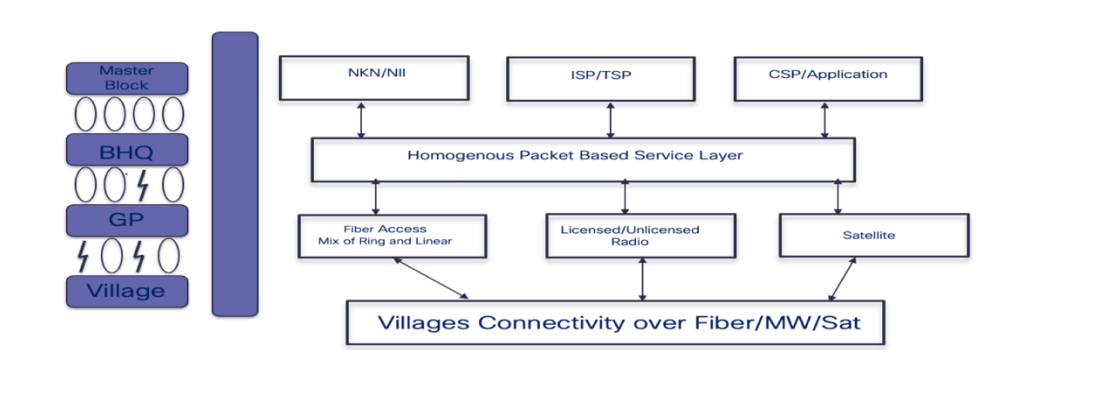Most of India lives in Rural and connecting them to the mainstream is key for the development of the country and digitization is the key to connecting them to the mainstream.
Digitization aims to curb the issue related to inefficiency, transparency, time-bound work, and fair play competition on a wide field platform.
The vision is to digitize Education, Health, Agriculture, Power, and Skill development which will help to bring the best of the world to villages also and help in improving the services.
The journey has started in this direction but here are some Stats on the penetration of Internet access to Rural populations:
- 70% Rural population has minimum or no internet to access digital service
- 93% of broadband penetration is in Urban areas, 29.3% in rural areas.
This highlights a clear digital divide between Rural and Urban India. The government of India has taken many initiatives to bridge this gap. One of the Key initiatives is Bharatnet.
Bharatnet is a Government of India flagship initiative to provide digital access by connecting all the Gram panchayat and villages with Optical fiber to enable high- speed internet and Citizen services.
On 25 October 2011 Government of India launched National Optical Fiber Network (NOFN) which later was renamed Bharatnet. The aim was to connect all 250,000- gram panchayats in the country covering nearly 625,000 villages, by utilizing the optical fiber network. To achieve this, Bharat Broadband Network was incorporated as a Special Purpose Vehicle (SPV) on 25 February 2012 under the Companies Act of 1956. Since then a lot of work has been done in this area.
There are two major components for deploying the Bharatnet
- Optical Fibre Cable
- Active Equipment
In Bharatnet Phase-1 and Phase-2 GPON was chosen as the Active Equipment for delivering Internet services. Most of the states were deployed with GPON except few who chose IP/MPLS as the technology for active equipment.
Few Government & Social Sector Services envisaged over Bharatnet:
- Broadband And Entertainment: Broadband and access to the internet was the first use case for which Bharatnet was conceptualized. Apart from the internet, services like IPTV, VOD, access to OTT, Internet-based call, connectivity to offices, and VLEs can also be provided.
- Health: Telemedicine and Remote Health requires will require a service-aware robust network as most of the consultations will happen over Video. The major use case will be Remote Consultation and Critical Care Monitoring. The government also intends to utilize Bharatnet to monitor different health and social schemes such as RMNCH+A, and AMRUT.
- Education and Skill Development: Remote Education and Skill development will require a lot of Content and Video delivery using Unicast and Multicast applications. Certification of courses, My time learning, Access to a Repository of material, Monitoring of teachers, staff, and Quality checks for Mid-day meals and other programs will be some key objectives that will be achieved using technology.
- Governance/SWANs Connectivity: The government is spending a lot of money on leasing capacity from the service provider for e-governance and SWAN connectivity. The same will be achieved by Bharatnet and Opex will be reduced.
- Agriculture: Ministry of Rural Development and Agriculture is exploring how technology can be utilized for improving agriculture. The IoT-based solution can be deployed for automated irrigation, information on Soil type, information on Crops, and other advice which can be helpful to farmers.
IP/MPLS-based Bharatnet Design and Advantages:
Advantages:
- One network for all Services: With IP/MPLS and Segment Routing we can create a unified Backhaul network for all services irrespective of whether it is a Layer2 (Point to Point, Point to Multipoint), Layer3 (Hub and Spoke, Mesh and Extranet) or Multicast. This gives the flexibility of having a single network in remote places for all services.
Bharatnet backhaul can be used to carry multiple services like IPTV, Broadband, connecting Schools, Hospitals, and much more with defined Quality of Service and Service level agreements. This will also be an enabler for 4G and 5G services in a remote village.
- Convergence and Resiliency: With the use of IP/MPLS technology we can always ensure faster convergence which is critical for Video and other sensitive applications. This also allows us to define multiple service gateway to ensure higher application availability in remote areas.
- Quality of Service: Rich and granular QoS with deep queuing and Hierarchical QoS capabilities ensure that each traffic gets the treatment that is required to run a particular application. Critical services are treated with priority but at the same time, other services are not starved. • Automation and Orchestration: Multi OEM Automation is key for any network. Bharatnet is a large network with multiple moving pieces, and this requires a control and management tool to regulate and automate the services. Support for enabling automation is inherently available with IP/MPLS.
- SLA-based Service: Bharatnet will be running multiple services like Broadband, IPTV, Schools, Health, Telcom services, etc. Each service will have a unique requirement, and some may require stringent SLAs. Capabilities of application-driven routing to ensure SLA will be key. Parameters like Bandwidth availability, Security, link health, Cost of bandwidth, etc. can be used to decide this. This capability can also be integrated with an automation engine to avoid any manual intervention.
- Security: Bharatnet will be running some critical services and ensuring the network is secure and no rouge device can be plugged in is one of the important requirements. IP/MPLS hardware supports Anti-counterfeit and Trust Anchor Infrastructure. Enabling Image Signing and Secure Boot features makes sure that the device can boot with authorized OS only. DDoS Protection with Visualization and Reporting can also help in mitigating malicious traffic. IP/MPLS Based
IP/MPLS Based Architecture:
IP/MPLS offers flexibility and service richness which makes it a de-facto choice for deploying and upgrading Bharatnet. IP/MPLS-based Bharatnet Architecture is a ring-based self-healing network. Gram panchayats and Villages are dual home (Preferably) to Blocks and Blocks are dualhomed to a Master Block. A master block is geographically situated in a location where peering with TSP, ISP, and CDN players is feasible. The dual Homing architecture not only enhances the network performance but also cuts down on fiber length and pluggable expenses. IP/MPLS-based architecture builds a highly resilient network that gives the flexibility to peer with Government institutions, TSPs, ISPs, and CDN players.
 To conclude I want to say that Bharatnet will be the backbone for all digital initiatives.
To conclude I want to say that Bharatnet will be the backbone for all digital initiatives.
India has a strong vision for Digitisation and Bharatnet is the key to success. A lot of effort and money has been pumped into this and we have seen some initial success. A lot more work has to be done to bring more and more population under the ambit of connected India With the focus, resolve, and selection of the right technology there is no doubt about the Success of Bharatnet.

 To conclude I want to say that Bharatnet will be the backbone for all digital initiatives.
To conclude I want to say that Bharatnet will be the backbone for all digital initiatives.